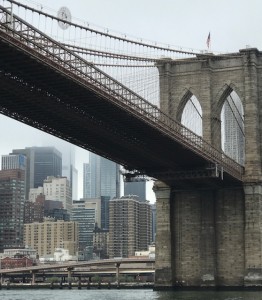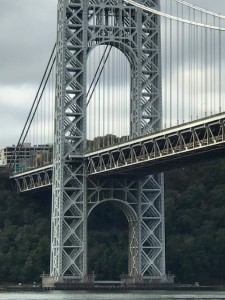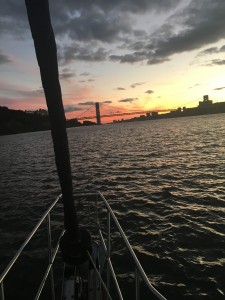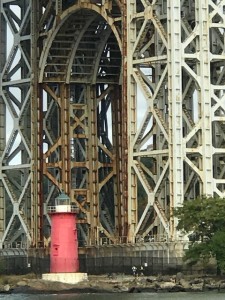Do you want to know who you are? Don’t ask. Act! Action will delineate and define you.
(Thomas Jefferson)
On Saturday, October 14, Dave, along with two friends: Karen and Steve, sailed down the East River from Long Island Sound – beneath 9 iconic bridges, by the skyscrapers of Lower Manhattan and the copper-robes of Lady Liberty, up the Hudson River, under the George Washington Bridge to our mooring at La Marina – meandering a course of 35 scenic-city-miles gifted by the ebb and flood of three rivers.
Although I had been to New York City many times, I felt as though I was seeing the Big Apple for the first time (for why NYC is referred to as the Big Apple, check out this link). Seeing the city from the
water was exciting and gave a completely different perspective than from a cab on Broadway. Starting with the rapid current of the East River, particularly at the infamous Hell Gate where the Harlem River joins the ebb-party along with several accomplices: tide, current, and wind – to grab the attention of boat and helmsman, all while traveling over 10 knots in a boiling froth (hey, no need to pay for an amusement park ride at Coney Island, this ride gives the same thrill with you at the helm). Heaven!
One of the coolest parts of the day, however, was approaching NYC’s historic bridges from the water and looking up from beneath and seeing the structural components of beams and girders I had noticed from land (or while driving over them) suddenly transform into art – an artistic arrangement of triangles, beautiful stone work, symmetrical columns, draping crescent-shaped cables, and the Christmas-tree-lights of night.
We timed the rhythm of our day with the tides: heading down the East River from New Rochelle, NY
on an ebb tide and up the Hudson on a flood. This gave visceral meaning to the vernacular: “Go with the flow.” Yes, we planned our day to go with the flow, and on our journey, we happened to discover the magic that arrives from wide-eyed wonder yielding to the flow of nature and opening ourselves to the beauty around us. Witnessing the creative architectural designs of buildings, bridges, statues and art, made me wonder: “With all our creative genius, are we not capable of cleaning up a river, designing cradle to cradle products, producing energy that doesn’t pollute, protecting clean air and water for our children?” The answer of course is a resounding YES!” Yes we are! And the field of design is ripe for our creative, life-giving ideas. Check out Janine Benyus’s Biomimicry Ted Talk for how we can design with nature as architect. We have proven examples of sustainable design from buildings to products that are healthier, safer and more pleasurable to use. It’s all in the design and in our commitment to employ sensible ideas.
So why did CELL sail to NYC? The practical reason was to conduct Climate Action Now (CAN) programs at two schools: the Columbia Grammar and Preparatory School and the Ethical Culture Fieldston School. As mentioned in a previous blog, students today are inundated with the
bad news of what we are doing to our environment. And bad news engenders despair and despair generates hopelessness and hopelessness results in inaction. So, to inspire action, we need to give students a sense of agency, a sense of hope. Not Pollyanna-hope, but realistic hope – hope carved out of the granite-like examples of inspiring people committed to living what is possible. Yes, the problems are big, but the SOLUTIONS are BIGGER. That’s the foundation stone for CAN. And that is what we will be inviting people to do: envision what is possible, find a community of support, and go do it!
And a foundation stone of our work is taken from Thomas Jefferson’s quote at the top of the blog: “Do you want to know who you are? Don’t ask. Act! Action will delineate and define you”. It’s not enough to simply give students information. We need to call them to action and expect that they can and will answer the call. And, of course, to answer the call, they will need knowledge and skill development along the way. But most importantly, they need to be inspired and they need to see and feel that there is a spark in their bellies that is awaiting their ignition into fire.
So, I felt a bit daunted today by this goal. Walking into a school of bright students who have a multiplicity of tasks pulling at them: from rigorous academics to sports, from music and dance lessons to community service projects, from peer relationships to family life… Given the pulls and distractions of life, how do concerns about the state of our planet compete? How does one inspire a sense of hopeful planetary urgency; a sense that we can create the solutions to the problems we face; and that you (every person) can step up to the task, take action and do it? So, that’s the goal of CAN, and I suppose why I was feeling a bit challenged by the work.
As always, I welcome your thoughts, ideas, stories, and suggestions on how to do this work more effectively. I am no expert, just a guy on a boat on a mission to learn as much as I can and to share the wisdom of people like you who have confronted the tigers of life and found a way to survive, or how to tame a tiger, or turn it into a kitten… When I invite your ideas, I am sincere and want to hear from you. Perhaps together we can spread a tangible message of hope that will change the world.
I also wanted to mention that beyond the practical reason for CAN is another reason I am discovering gradually as I sail: it’s to discover the beauty, art, and love in the world around me (and you). And I have this hunch: people protect what they love. It’s that simple! So, how do we inspire the love that will protect our rivers, fight for clean air, reduce carbon pollution, stop the production of single-use plastics that are clogging our oceans and killing marine life… How do we do that? Parents, for example, don’t worry if they will have the energy to protect their children. They just do it. It’s instinctive. It flows from their deep love and connection. That’s what I am searching for: how do we engender that same love for our one and only beautiful home planet? Check out this 3-minute Carl Sagan video: Pale Blue Dot. It captures what I’m talking about.
A first step may be to put down our cell phones, go outside and feel the warmth of the sun on our skin, the smell of fall in the woods, the sounds of geese migrating in the sky above us, the taste of honey while considering its miraculous story… Wendell Berry said: “What I stand for is what I stand on.” You can start today by falling in love with what you stand on, what gives you life, what asks simply for you to open your eyes and feel connected. This you can do today.
Did you know that 94% of all life on Earth is aquatic? That makes us land-lubbers a pretty small minority.
Plastic pollution is killing our oceans. Click this link for a quick step you can take right now to add your name to a growing list of people demanding that plastics not enter our oceans.
Stay tuned: Our next blog will recap a 450 nautical mile journey from New York City to Chesapeake Bay and up the Potomac to Washington D.C. (FYI – a nautical mile = 1.15 statute miles).
To subscribe to (or unsubscribe from) these blog posts, write to jonathan@cellonline.org.
*CELL is currently accepting applications for college sustainability focused study abroad programs, to Iceland, Central America, Ecuador, and Scotland. Faculty may contact CELL regarding custom programs for your college. Go to cellonline.org for more information and to apply.”




